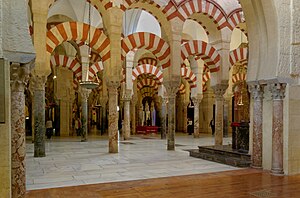Mezquita de Córdoba
The Mezquita (Spanish for "mosque") of Cordoba is a Roman Catholic cathedral. It used to be a mosque in the Andalusian city of Córdoba, Spain. [1] At first the site had been used for a temple, then a Christian cathedral. Under the rule of Islam, it was built as the second-largest mosque in the world. It is perhaps the most accomplished monument of the Umayyad dynasty of Cordoba. It changed into mosque in Middle Ages. [2]After the Spanish Reconquista, it was changed back into a church, and some of the Islamic columns and arcs were replaced by a basilica in early Baroque style. Many early mosques have a square or rectangular plan. They also have a prayer hall and an enclosed courtyard. This is known as Arab-plan. The first mosques of this type were built during the Umayyad Dynasty.


In the warm Mediterranean and Middle Eastern climates, the courtyard served to hold the large number of worshippers during Friday prayers. Often, hypostyle mosques have outer arcades. They allow the visitors to enjoy the shade. Arab-plan mosques were built mostly during the Umayyad and Abbasid dynasties. The Arab plan was very simple, which did not allow for much further development. This caused that style of mosque to fall out of favour.[3] The flat roof of the prayer hall was supported by columns. Many rows of columns were needed to support such roofs;.[4] this is called "hypostyle architecture". Today it houses the main church of the diocese of Cordoba in Spain. One of the most famous hypostyle mosques, it is supported by over 850 columns.[5]
References
change- ↑ Daniel, Ben (2013). The Search for Truth about Islam. Westminster John Knox Press. p. 93. ISBN 9780664237059. Retrieved 24 August 2014.
The church is Catholic and has been for centuries, but when Catholic Spaniards expelled the local Arabic and Muslim population (the people they called the Moors) in 1236, they didn't do what the Catholic Church tended to do everywhere else when it moved in and displaced locally held religious beliefs: they didn't destroy the local religious shrine and build a cathedral of the foundations of the sacred space that had been knocked down. Instead, they built a church inside and up through the roof of the mosque, and then dedicated the entire space to Our Lady of the Assumption and made it the cathedral for the Diocese of Cordoba.
- ↑ Guia, Aitana (1 July 2014). The Muslim Struggle for Civil Rights in Spain, 1985–2010: Promoting Democracy Through Islamic Engagement. Sussex Academic Press. p. 137. ISBN 9781845195816.
It was originally a small temple of Christian Visigoth origin. Under Umayyad reign in Spain (711–1031 CE), it was expanded and made into a mosque, which it would remain for eight centuries. During the Christian conquest of Al-Andalus, Christians captured the mosque and consecrated it as a Catholic church.
- ↑ Hillenbrand, R. "Masdjid. I. In the central Islamic lands". In P.J. Bearman, Th. Bianquis, C.E. Bosworth, E. van Donzel and W.P. Heinrichs (ed.). Encyclopaedia of Islam Online. Brill Academic Publishers. ISSN 1573-3912.
{{cite encyclopedia}}: CS1 maint: multiple names: editors list (link) - ↑ Hillenbrand, R. "Masdjid. I. In the central Islamic lands". In P.J. Bearman, Th. Bianquis, C.E. Bosworth, E. van Donzel and W.P. Heinrichs (ed.). Encyclopaedia of Islam Online. Brill Academic Publishers. ISSN 1573-3912.
{{cite encyclopedia}}: CS1 maint: multiple names: editors list (link) - ↑ Hillenbrand, R. "Masdjid. I. In the central Islamic lands". In P.J. Bearman, Th. Bianquis, C.E. Bosworth, E. van Donzel and W.P. Heinrichs (ed.). Encyclopaedia of Islam Online. Brill Academic Publishers. ISSN 1573-3912.
{{cite encyclopedia}}: CS1 maint: multiple names: editors list (link)